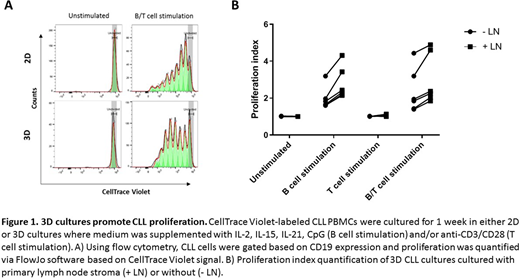INTRODUCTION. Primary chronic lymphocytic leukemia (CLL) cells, despite originating from a proliferative disease, rapidly undergo apoptosis in vitro in absence of microenvironmental survival signals1. Although co-culture with stromal cells or the addition of soluble factors can increase and extend CLL survival, no system permits the long-term expansion of CLL cells in vitro2. The difficulties of mimicking a physiologic microenvironment supporting CLL cells hinder in vitro studies of proliferation, drug screens and prevent propagation of rare subclones. For other cancers, various types of 3D cultures have been introduced utilizing scaffolds, gels, spheroid cultures and fluidic systems, representing a more accurate representation of the in vivo microenvironment3. Unlike solid tumors, secondary lymphoid tissues where CLL cells proliferate in vivo, do not derive from a single stem cell progenitor. Developing an appropriate 3D in vitro culture system for CLL is of obvious importance and may contribute pathophysiological relevance to study long-term CLL proliferation and more accurate drug screening4,5. Within the field of CLL, attempts have focused on bone marrow stroma, but it may be biologically and clinically more relevant to investigate the lymph node niche as this is the critical site of CLL proliferation6.
METHODS. Primary CLL cells were cultured in various 3D systems including hydrogels, hanging drop cultures and ultra-low attachment plates (ULA) plates in parallel to an optimal 2D system, consisting of the culture of primary CLL cells on a monolayer of CD40L-presenting fibroblasts (3T40) or 3T3 negative control fibroblasts. CLL cells were either cultured as PBMCs alone, with or without T cells, or co-cultured with 3T40 or primary lymph node fibroblasts. CLL cells were either stimulated directly with IL-2, IL-15, IL-21 and CpG and/or indirectly via a T cell stimulation of anti-CD3/CD28.
RESULTS. After testing and comparing multiple systems for the in vitro culture of CLL cells, we optimized a novel CLL culture system utilizing ULA plates creating spheroids of PBMCs isolated from peripheral blood. Without the addition of soluble factors or stroma, primary CLL cells in the ULA 3D model could be maintained in culture for 6 weeks as opposed to 1 week in the 2D system. Aside from significantly promoting CLL survival, cultures could be expanded approximately 3-4-fold over a course of 6 weeks using the ULA 3D model. 3D cultures showed a more consistent and significantly increased CLL proliferation compared to 2D cultures, independent of IGHV mutation status, increasing the average proliferation index of 2.87 to 3.90 (n=10). Additionally, co-culture with LN-derived stromal cells further increased CLL proliferation, reaching a maximum of 8 generations (n=6) (Figure 1). Lastly, when PBMCs were stimulated with IL-2, IL-15, IL-21 and CpG, spheroids developed proliferation center-like structures after 4 weeks of culture.
CONCLUSIONS. We established a lymph node-based 3D in vitro culture system for CLL leading to increased CLL proliferation and survival compared to 2D systems. The set-up allows long-term expansion of CLL cells in vitro, as well as formation of proliferation center-like structures. We are currently optimizing drug resistance studies, expansion of specific CLL subclones and performing competition experiments.
References:
1. Hamilton et al., Mimicking the tumour microenvironment: three different co-culture systems induce a similar phenotype but distinct proliferative signals in primary chronic lymphocytic leukaemia cells, 2012.
2. Asslaber et al., Mimicking the microenvironment in chronic lymphocytic leukaemia - where does the journey go?, 2013.
3. Gurski et al., 3D Matrices for Anti-Cancer Drug Testing and Development, 2010.
4. Nunes et al., 3D tumor spheroids as in vitro models to mimic in vivo human solid tumors resistance to therapeutic drugs, 2019.
5. Aljitwai et al., A novel three-dimensional stromal-based model for in vitro chemotherapy sensitivity testing of leukemia cells, 2014.
6. Van Gent et al., In vivo dynamics of stable chronic lymphocytic leukemia inversely correlates with somatic hypermutation levels and suggest no major leukemic turnover in bone marrow, 2008.
Kater:Genentech: Research Funding; Abbvie: Research Funding; Roche: Research Funding; Janssen: Research Funding; Celgene: Research Funding. Eldering:Celgene: Research Funding; Janssen: Research Funding; Genentech: Research Funding.
Author notes
Asterisk with author names denotes non-ASH members.


This feature is available to Subscribers Only
Sign In or Create an Account Close Modal